Organizational Behaviour Analysis Report - Unit 12, HND
VerifiedAdded on 2022/11/13
|20
|5261
|312
Report
AI Summary
This report provides a detailed analysis of organizational behavior, focusing on the interplay of culture, power, and politics within a UK-based retail organization. It critically evaluates the relationships between these factors and their impact on employee performance and motivation, addressing issues like high staff turnover. The report then assesses various motivational theories, including Maslow's Hierarchy of Needs and Herzberg's Two-Factor Theory, offering recommendations for enhancing employee motivation and performance. Furthermore, it critically examines the process of team development, exploring team-building theories and the contribution of effective teams to organizational success. The analysis also applies different concepts and philosophies of organizational behavior to understand their impact on employee behavior and performance, providing a comprehensive overview of the subject matter.
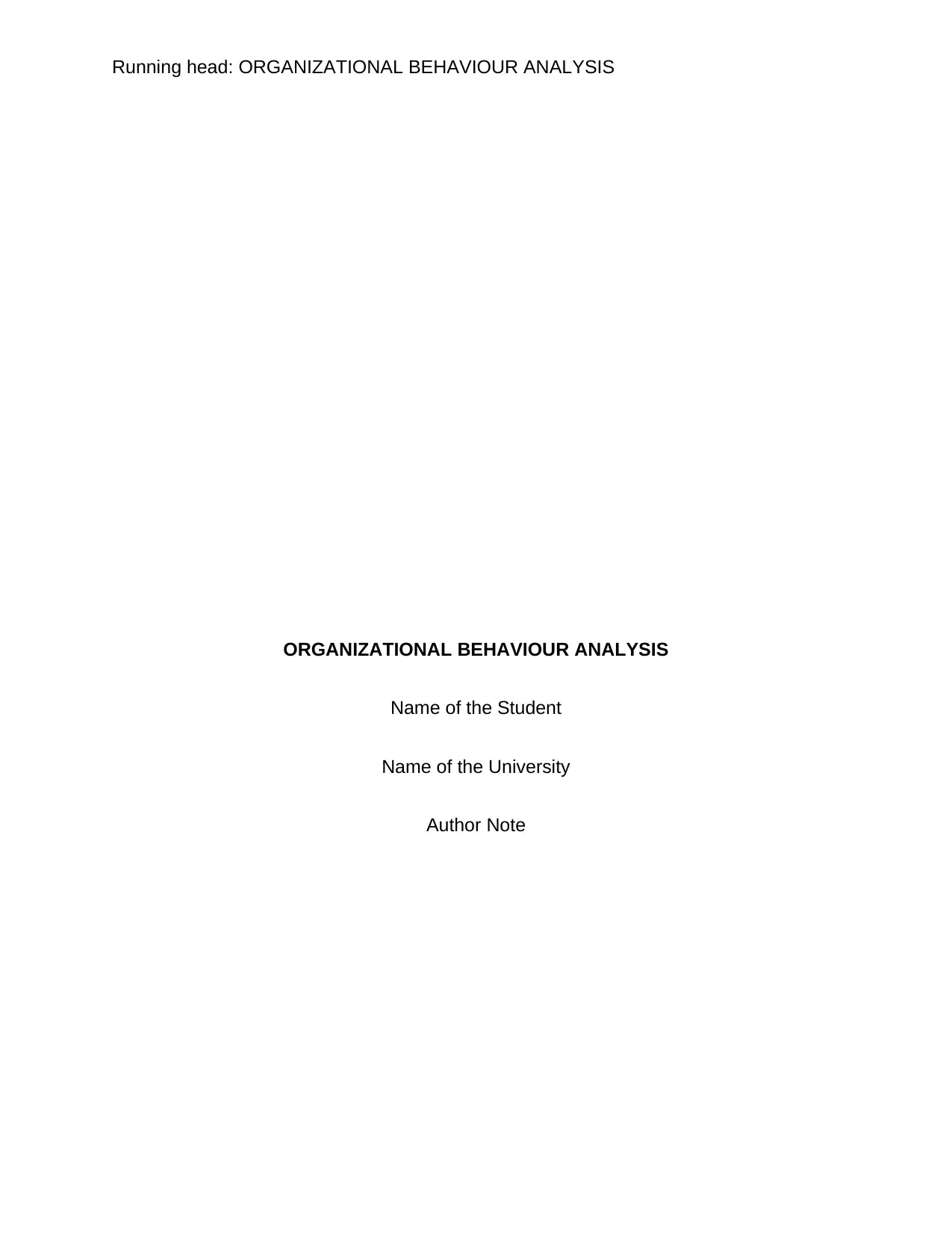
Running head: ORGANIZATIONAL BEHAVIOUR ANALYSIS
ORGANIZATIONAL BEHAVIOUR ANALYSIS
Name of the Student
Name of the University
Author Note
ORGANIZATIONAL BEHAVIOUR ANALYSIS
Name of the Student
Name of the University
Author Note
Paraphrase This Document
Need a fresh take? Get an instant paraphrase of this document with our AI Paraphraser
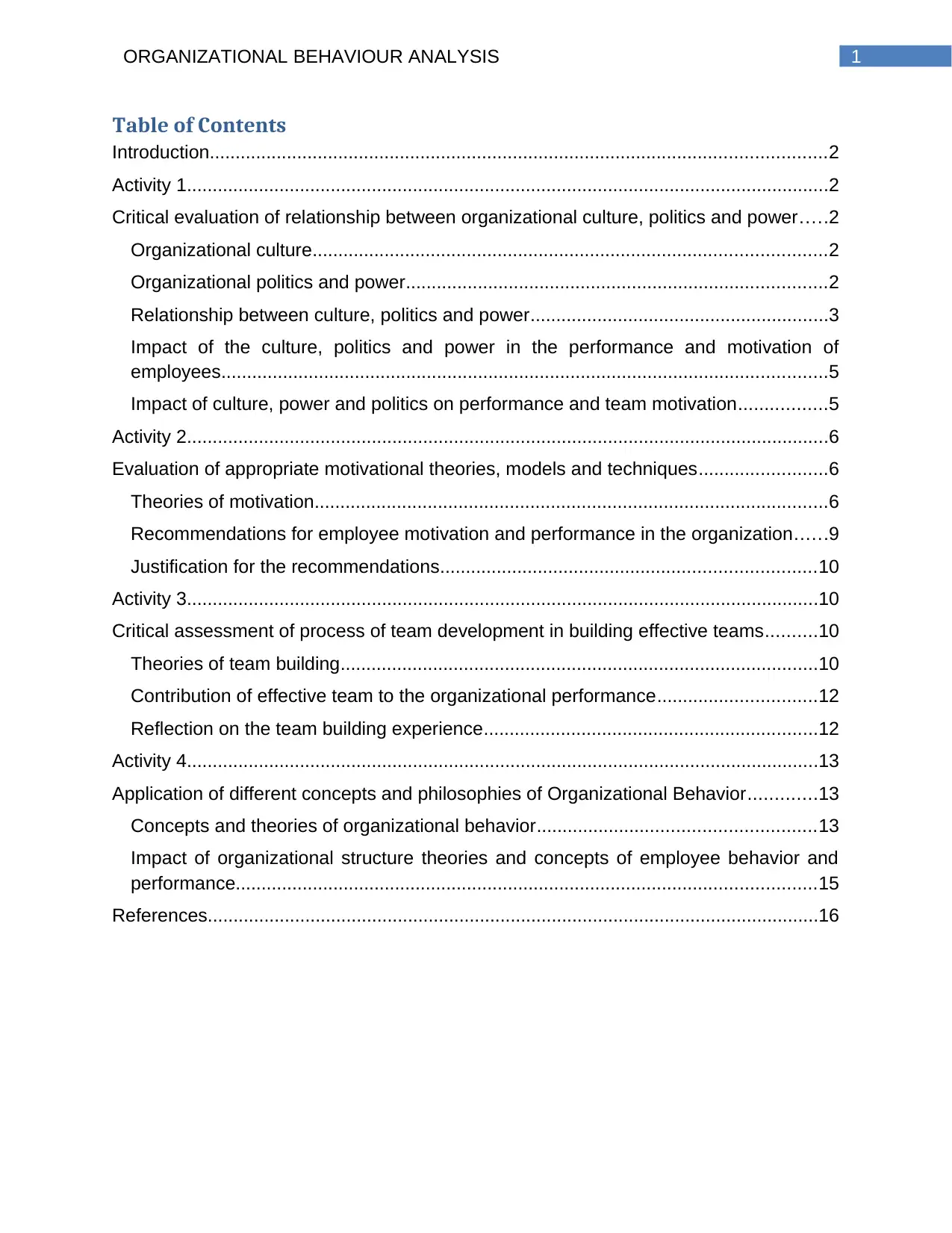
1ORGANIZATIONAL BEHAVIOUR ANALYSIS
Table of Contents
Introduction........................................................................................................................2
Activity 1.............................................................................................................................2
Critical evaluation of relationship between organizational culture, politics and power.....2
Organizational culture....................................................................................................2
Organizational politics and power..................................................................................2
Relationship between culture, politics and power..........................................................3
Impact of the culture, politics and power in the performance and motivation of
employees......................................................................................................................5
Impact of culture, power and politics on performance and team motivation.................5
Activity 2.............................................................................................................................6
Evaluation of appropriate motivational theories, models and techniques.........................6
Theories of motivation....................................................................................................6
Recommendations for employee motivation and performance in the organization......9
Justification for the recommendations.........................................................................10
Activity 3...........................................................................................................................10
Critical assessment of process of team development in building effective teams..........10
Theories of team building.............................................................................................10
Contribution of effective team to the organizational performance...............................12
Reflection on the team building experience.................................................................12
Activity 4...........................................................................................................................13
Application of different concepts and philosophies of Organizational Behavior.............13
Concepts and theories of organizational behavior......................................................13
Impact of organizational structure theories and concepts of employee behavior and
performance.................................................................................................................15
References.......................................................................................................................16
Table of Contents
Introduction........................................................................................................................2
Activity 1.............................................................................................................................2
Critical evaluation of relationship between organizational culture, politics and power.....2
Organizational culture....................................................................................................2
Organizational politics and power..................................................................................2
Relationship between culture, politics and power..........................................................3
Impact of the culture, politics and power in the performance and motivation of
employees......................................................................................................................5
Impact of culture, power and politics on performance and team motivation.................5
Activity 2.............................................................................................................................6
Evaluation of appropriate motivational theories, models and techniques.........................6
Theories of motivation....................................................................................................6
Recommendations for employee motivation and performance in the organization......9
Justification for the recommendations.........................................................................10
Activity 3...........................................................................................................................10
Critical assessment of process of team development in building effective teams..........10
Theories of team building.............................................................................................10
Contribution of effective team to the organizational performance...............................12
Reflection on the team building experience.................................................................12
Activity 4...........................................................................................................................13
Application of different concepts and philosophies of Organizational Behavior.............13
Concepts and theories of organizational behavior......................................................13
Impact of organizational structure theories and concepts of employee behavior and
performance.................................................................................................................15
References.......................................................................................................................16
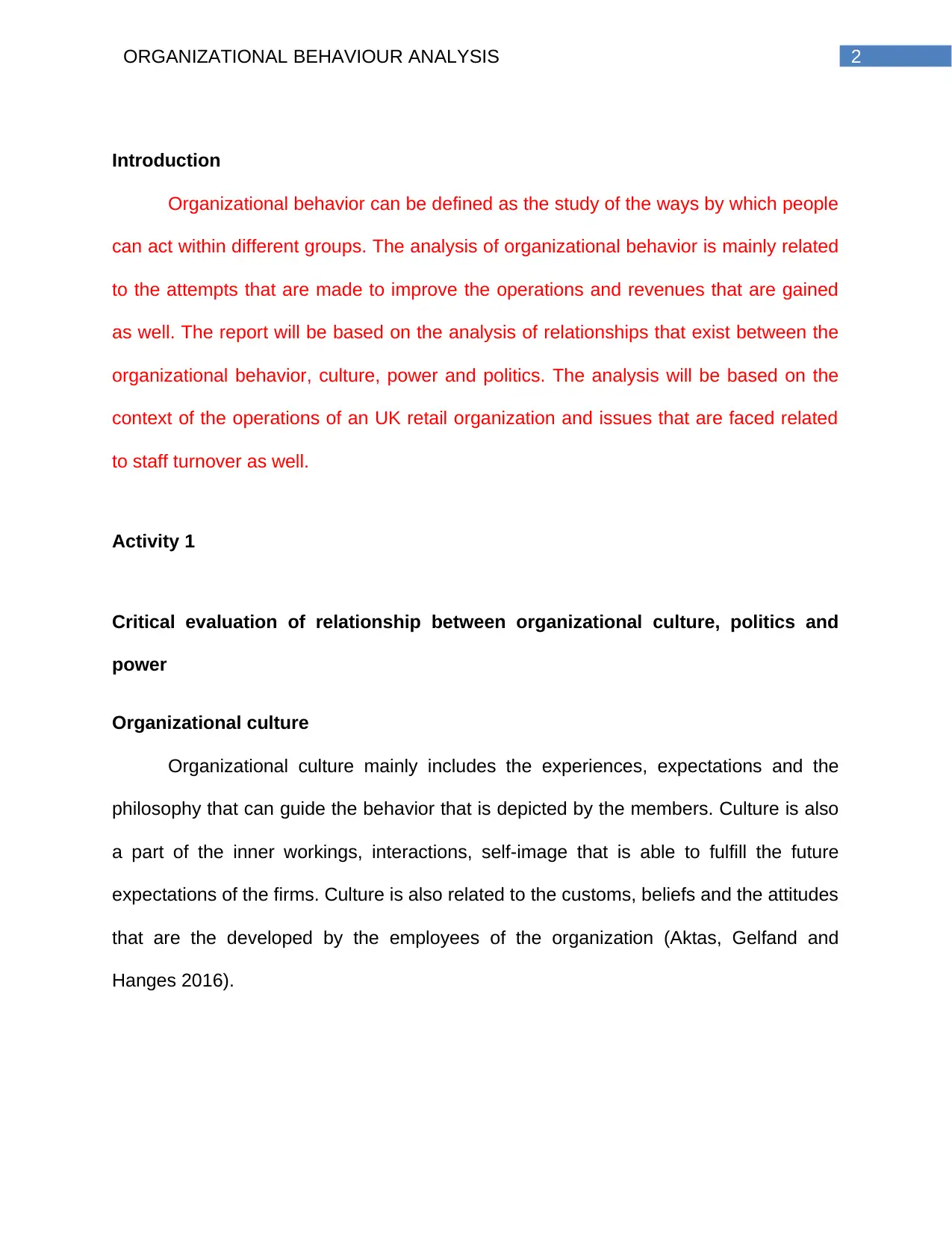
2ORGANIZATIONAL BEHAVIOUR ANALYSIS
Introduction
Organizational behavior can be defined as the study of the ways by which people
can act within different groups. The analysis of organizational behavior is mainly related
to the attempts that are made to improve the operations and revenues that are gained
as well. The report will be based on the analysis of relationships that exist between the
organizational behavior, culture, power and politics. The analysis will be based on the
context of the operations of an UK retail organization and issues that are faced related
to staff turnover as well.
Activity 1
Critical evaluation of relationship between organizational culture, politics and
power
Organizational culture
Organizational culture mainly includes the experiences, expectations and the
philosophy that can guide the behavior that is depicted by the members. Culture is also
a part of the inner workings, interactions, self-image that is able to fulfill the future
expectations of the firms. Culture is also related to the customs, beliefs and the attitudes
that are the developed by the employees of the organization (Aktas, Gelfand and
Hanges 2016).
Introduction
Organizational behavior can be defined as the study of the ways by which people
can act within different groups. The analysis of organizational behavior is mainly related
to the attempts that are made to improve the operations and revenues that are gained
as well. The report will be based on the analysis of relationships that exist between the
organizational behavior, culture, power and politics. The analysis will be based on the
context of the operations of an UK retail organization and issues that are faced related
to staff turnover as well.
Activity 1
Critical evaluation of relationship between organizational culture, politics and
power
Organizational culture
Organizational culture mainly includes the experiences, expectations and the
philosophy that can guide the behavior that is depicted by the members. Culture is also
a part of the inner workings, interactions, self-image that is able to fulfill the future
expectations of the firms. Culture is also related to the customs, beliefs and the attitudes
that are the developed by the employees of the organization (Aktas, Gelfand and
Hanges 2016).
⊘ This is a preview!⊘
Do you want full access?
Subscribe today to unlock all pages.

Trusted by 1+ million students worldwide
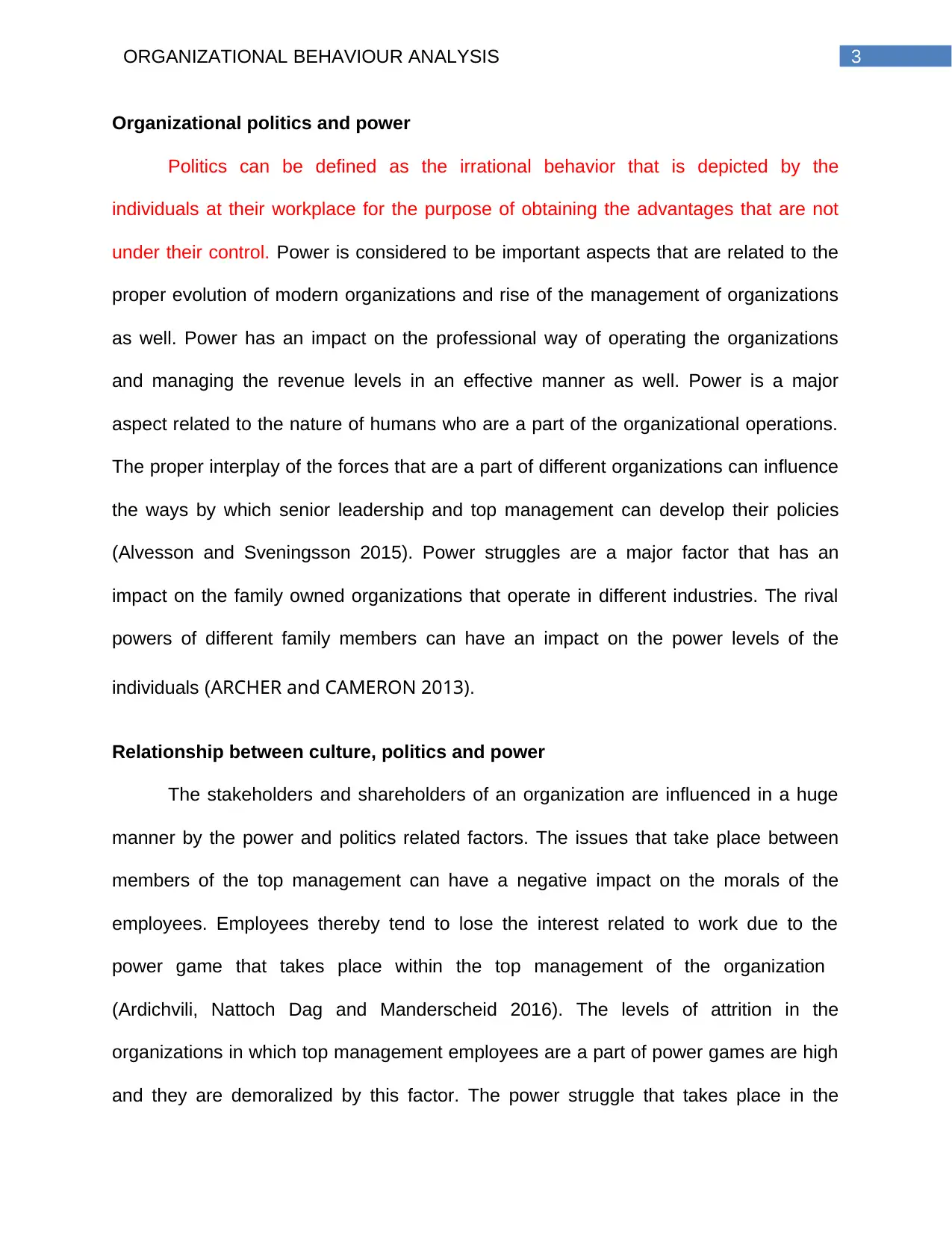
3ORGANIZATIONAL BEHAVIOUR ANALYSIS
Organizational politics and power
Politics can be defined as the irrational behavior that is depicted by the
individuals at their workplace for the purpose of obtaining the advantages that are not
under their control. Power is considered to be important aspects that are related to the
proper evolution of modern organizations and rise of the management of organizations
as well. Power has an impact on the professional way of operating the organizations
and managing the revenue levels in an effective manner as well. Power is a major
aspect related to the nature of humans who are a part of the organizational operations.
The proper interplay of the forces that are a part of different organizations can influence
the ways by which senior leadership and top management can develop their policies
(Alvesson and Sveningsson 2015). Power struggles are a major factor that has an
impact on the family owned organizations that operate in different industries. The rival
powers of different family members can have an impact on the power levels of the
individuals (ARCHER and CAMERON 2013).
Relationship between culture, politics and power
The stakeholders and shareholders of an organization are influenced in a huge
manner by the power and politics related factors. The issues that take place between
members of the top management can have a negative impact on the morals of the
employees. Employees thereby tend to lose the interest related to work due to the
power game that takes place within the top management of the organization
(Ardichvili, Nattoch Dag and Manderscheid 2016). The levels of attrition in the
organizations in which top management employees are a part of power games are high
and they are demoralized by this factor. The power struggle that takes place in the
Organizational politics and power
Politics can be defined as the irrational behavior that is depicted by the
individuals at their workplace for the purpose of obtaining the advantages that are not
under their control. Power is considered to be important aspects that are related to the
proper evolution of modern organizations and rise of the management of organizations
as well. Power has an impact on the professional way of operating the organizations
and managing the revenue levels in an effective manner as well. Power is a major
aspect related to the nature of humans who are a part of the organizational operations.
The proper interplay of the forces that are a part of different organizations can influence
the ways by which senior leadership and top management can develop their policies
(Alvesson and Sveningsson 2015). Power struggles are a major factor that has an
impact on the family owned organizations that operate in different industries. The rival
powers of different family members can have an impact on the power levels of the
individuals (ARCHER and CAMERON 2013).
Relationship between culture, politics and power
The stakeholders and shareholders of an organization are influenced in a huge
manner by the power and politics related factors. The issues that take place between
members of the top management can have a negative impact on the morals of the
employees. Employees thereby tend to lose the interest related to work due to the
power game that takes place within the top management of the organization
(Ardichvili, Nattoch Dag and Manderscheid 2016). The levels of attrition in the
organizations in which top management employees are a part of power games are high
and they are demoralized by this factor. The power struggle that takes place in the
Paraphrase This Document
Need a fresh take? Get an instant paraphrase of this document with our AI Paraphraser
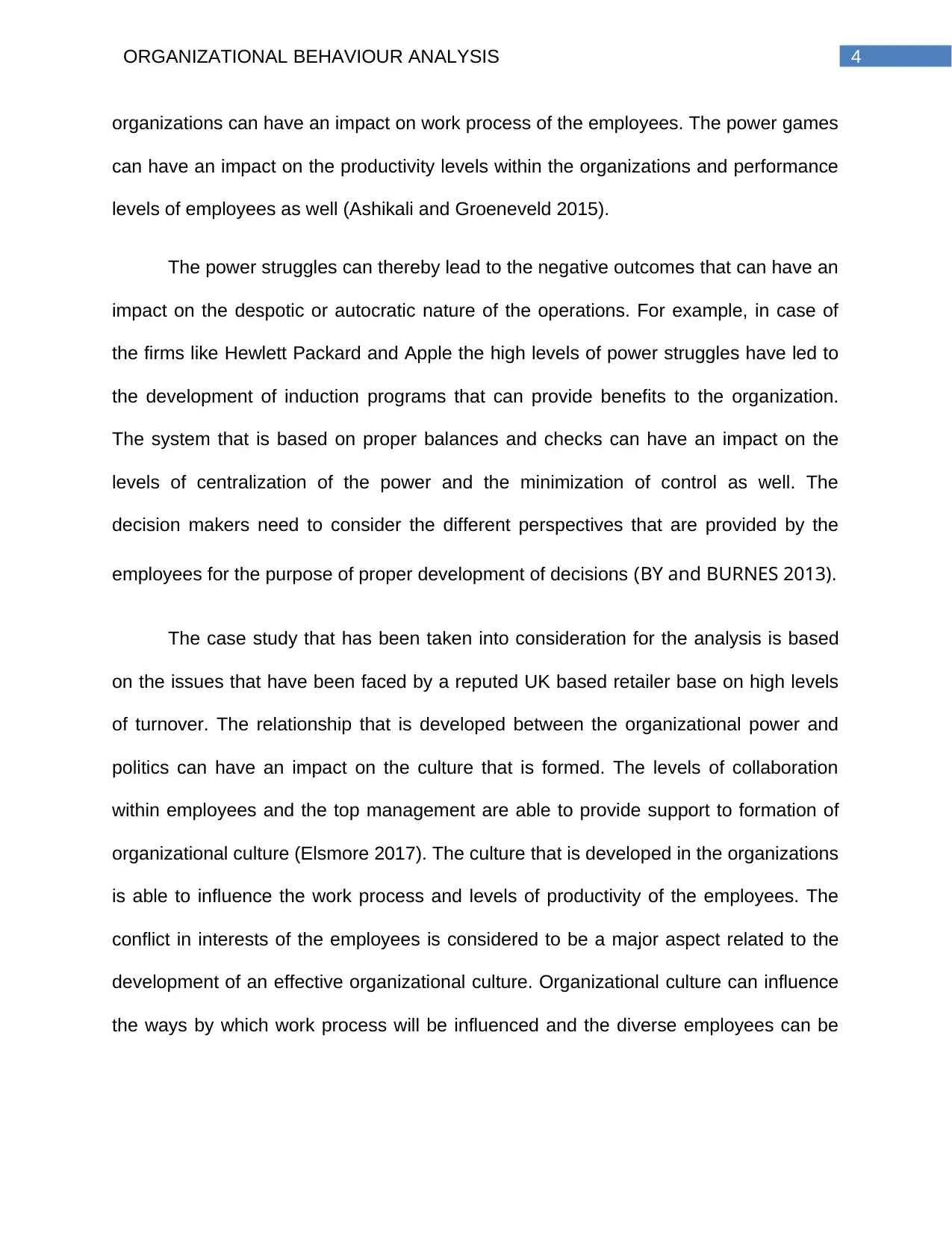
4ORGANIZATIONAL BEHAVIOUR ANALYSIS
organizations can have an impact on work process of the employees. The power games
can have an impact on the productivity levels within the organizations and performance
levels of employees as well (Ashikali and Groeneveld 2015).
The power struggles can thereby lead to the negative outcomes that can have an
impact on the despotic or autocratic nature of the operations. For example, in case of
the firms like Hewlett Packard and Apple the high levels of power struggles have led to
the development of induction programs that can provide benefits to the organization.
The system that is based on proper balances and checks can have an impact on the
levels of centralization of the power and the minimization of control as well. The
decision makers need to consider the different perspectives that are provided by the
employees for the purpose of proper development of decisions (BY and BURNES 2013).
The case study that has been taken into consideration for the analysis is based
on the issues that have been faced by a reputed UK based retailer base on high levels
of turnover. The relationship that is developed between the organizational power and
politics can have an impact on the culture that is formed. The levels of collaboration
within employees and the top management are able to provide support to formation of
organizational culture (Elsmore 2017). The culture that is developed in the organizations
is able to influence the work process and levels of productivity of the employees. The
conflict in interests of the employees is considered to be a major aspect related to the
development of an effective organizational culture. Organizational culture can influence
the ways by which work process will be influenced and the diverse employees can be
organizations can have an impact on work process of the employees. The power games
can have an impact on the productivity levels within the organizations and performance
levels of employees as well (Ashikali and Groeneveld 2015).
The power struggles can thereby lead to the negative outcomes that can have an
impact on the despotic or autocratic nature of the operations. For example, in case of
the firms like Hewlett Packard and Apple the high levels of power struggles have led to
the development of induction programs that can provide benefits to the organization.
The system that is based on proper balances and checks can have an impact on the
levels of centralization of the power and the minimization of control as well. The
decision makers need to consider the different perspectives that are provided by the
employees for the purpose of proper development of decisions (BY and BURNES 2013).
The case study that has been taken into consideration for the analysis is based
on the issues that have been faced by a reputed UK based retailer base on high levels
of turnover. The relationship that is developed between the organizational power and
politics can have an impact on the culture that is formed. The levels of collaboration
within employees and the top management are able to provide support to formation of
organizational culture (Elsmore 2017). The culture that is developed in the organizations
is able to influence the work process and levels of productivity of the employees. The
conflict in interests of the employees is considered to be a major aspect related to the
development of an effective organizational culture. Organizational culture can influence
the ways by which work process will be influenced and the diverse employees can be
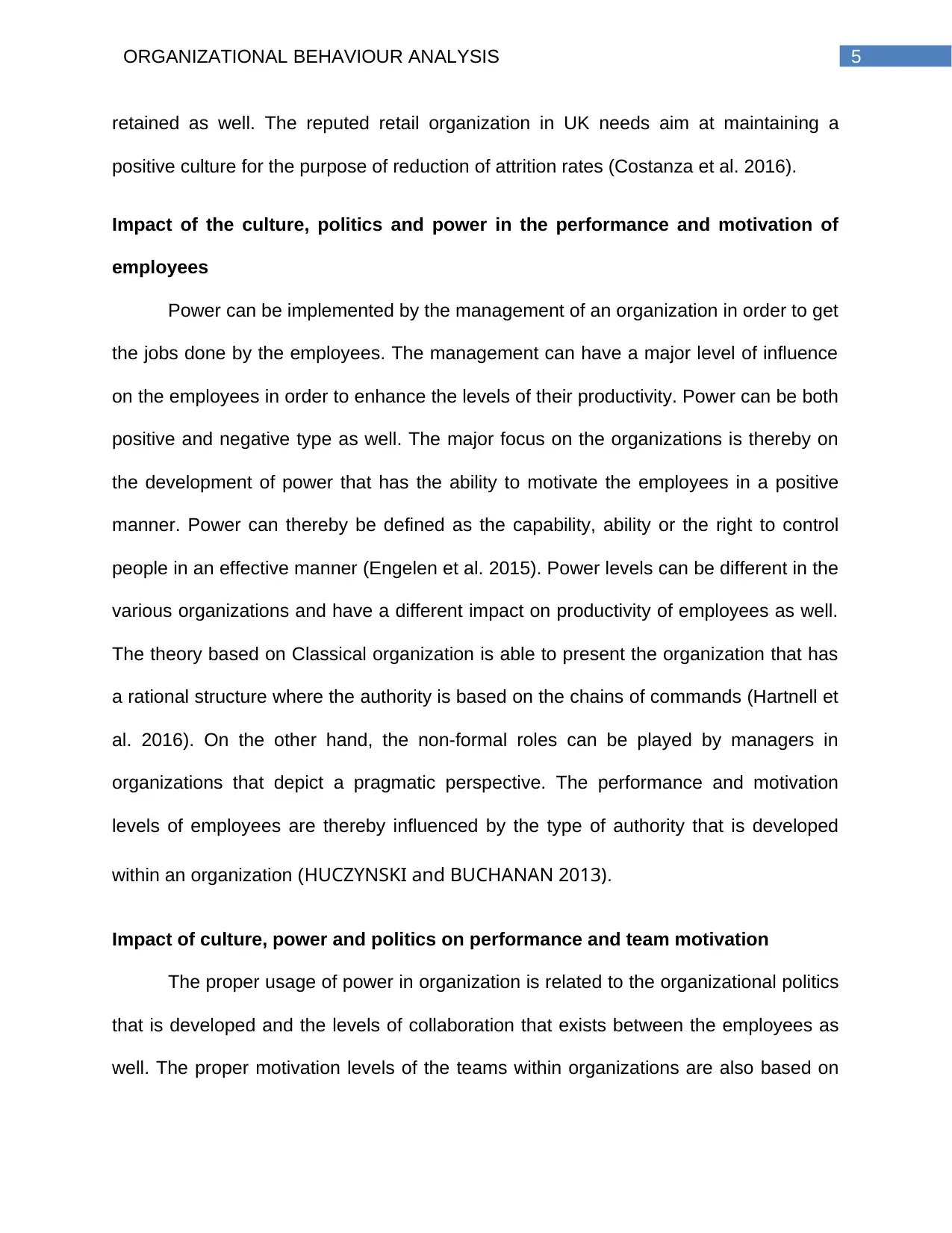
5ORGANIZATIONAL BEHAVIOUR ANALYSIS
retained as well. The reputed retail organization in UK needs aim at maintaining a
positive culture for the purpose of reduction of attrition rates (Costanza et al. 2016).
Impact of the culture, politics and power in the performance and motivation of
employees
Power can be implemented by the management of an organization in order to get
the jobs done by the employees. The management can have a major level of influence
on the employees in order to enhance the levels of their productivity. Power can be both
positive and negative type as well. The major focus on the organizations is thereby on
the development of power that has the ability to motivate the employees in a positive
manner. Power can thereby be defined as the capability, ability or the right to control
people in an effective manner (Engelen et al. 2015). Power levels can be different in the
various organizations and have a different impact on productivity of employees as well.
The theory based on Classical organization is able to present the organization that has
a rational structure where the authority is based on the chains of commands (Hartnell et
al. 2016). On the other hand, the non-formal roles can be played by managers in
organizations that depict a pragmatic perspective. The performance and motivation
levels of employees are thereby influenced by the type of authority that is developed
within an organization (HUCZYNSKI and BUCHANAN 2013).
Impact of culture, power and politics on performance and team motivation
The proper usage of power in organization is related to the organizational politics
that is developed and the levels of collaboration that exists between the employees as
well. The proper motivation levels of the teams within organizations are also based on
retained as well. The reputed retail organization in UK needs aim at maintaining a
positive culture for the purpose of reduction of attrition rates (Costanza et al. 2016).
Impact of the culture, politics and power in the performance and motivation of
employees
Power can be implemented by the management of an organization in order to get
the jobs done by the employees. The management can have a major level of influence
on the employees in order to enhance the levels of their productivity. Power can be both
positive and negative type as well. The major focus on the organizations is thereby on
the development of power that has the ability to motivate the employees in a positive
manner. Power can thereby be defined as the capability, ability or the right to control
people in an effective manner (Engelen et al. 2015). Power levels can be different in the
various organizations and have a different impact on productivity of employees as well.
The theory based on Classical organization is able to present the organization that has
a rational structure where the authority is based on the chains of commands (Hartnell et
al. 2016). On the other hand, the non-formal roles can be played by managers in
organizations that depict a pragmatic perspective. The performance and motivation
levels of employees are thereby influenced by the type of authority that is developed
within an organization (HUCZYNSKI and BUCHANAN 2013).
Impact of culture, power and politics on performance and team motivation
The proper usage of power in organization is related to the organizational politics
that is developed and the levels of collaboration that exists between the employees as
well. The proper motivation levels of the teams within organizations are also based on
⊘ This is a preview!⊘
Do you want full access?
Subscribe today to unlock all pages.

Trusted by 1+ million students worldwide
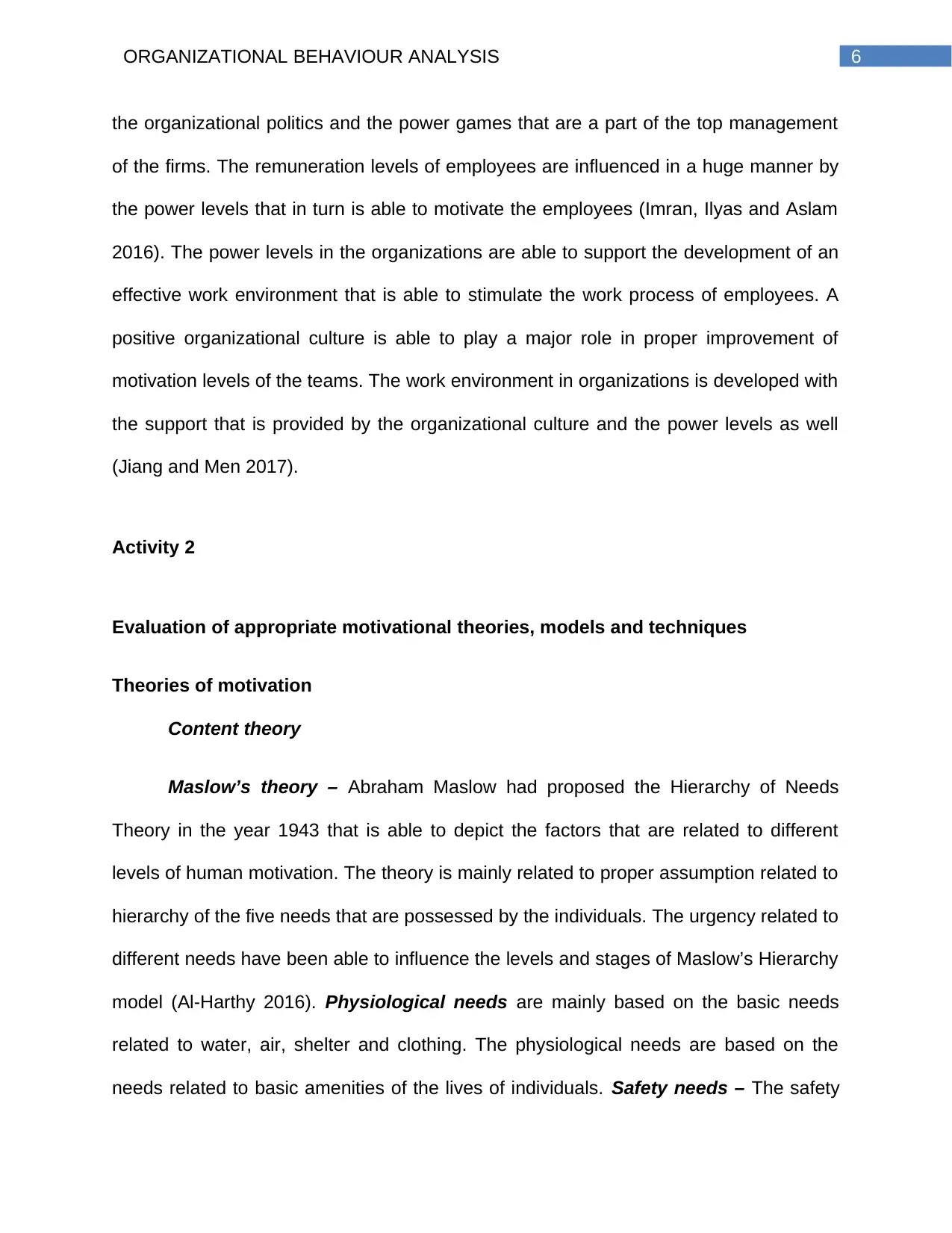
6ORGANIZATIONAL BEHAVIOUR ANALYSIS
the organizational politics and the power games that are a part of the top management
of the firms. The remuneration levels of employees are influenced in a huge manner by
the power levels that in turn is able to motivate the employees (Imran, Ilyas and Aslam
2016). The power levels in the organizations are able to support the development of an
effective work environment that is able to stimulate the work process of employees. A
positive organizational culture is able to play a major role in proper improvement of
motivation levels of the teams. The work environment in organizations is developed with
the support that is provided by the organizational culture and the power levels as well
(Jiang and Men 2017).
Activity 2
Evaluation of appropriate motivational theories, models and techniques
Theories of motivation
Content theory
Maslow’s theory – Abraham Maslow had proposed the Hierarchy of Needs
Theory in the year 1943 that is able to depict the factors that are related to different
levels of human motivation. The theory is mainly related to proper assumption related to
hierarchy of the five needs that are possessed by the individuals. The urgency related to
different needs have been able to influence the levels and stages of Maslow’s Hierarchy
model (Al-Harthy 2016). Physiological needs are mainly based on the basic needs
related to water, air, shelter and clothing. The physiological needs are based on the
needs related to basic amenities of the lives of individuals. Safety needs – The safety
the organizational politics and the power games that are a part of the top management
of the firms. The remuneration levels of employees are influenced in a huge manner by
the power levels that in turn is able to motivate the employees (Imran, Ilyas and Aslam
2016). The power levels in the organizations are able to support the development of an
effective work environment that is able to stimulate the work process of employees. A
positive organizational culture is able to play a major role in proper improvement of
motivation levels of the teams. The work environment in organizations is developed with
the support that is provided by the organizational culture and the power levels as well
(Jiang and Men 2017).
Activity 2
Evaluation of appropriate motivational theories, models and techniques
Theories of motivation
Content theory
Maslow’s theory – Abraham Maslow had proposed the Hierarchy of Needs
Theory in the year 1943 that is able to depict the factors that are related to different
levels of human motivation. The theory is mainly related to proper assumption related to
hierarchy of the five needs that are possessed by the individuals. The urgency related to
different needs have been able to influence the levels and stages of Maslow’s Hierarchy
model (Al-Harthy 2016). Physiological needs are mainly based on the basic needs
related to water, air, shelter and clothing. The physiological needs are based on the
needs related to basic amenities of the lives of individuals. Safety needs – The safety
Paraphrase This Document
Need a fresh take? Get an instant paraphrase of this document with our AI Paraphraser
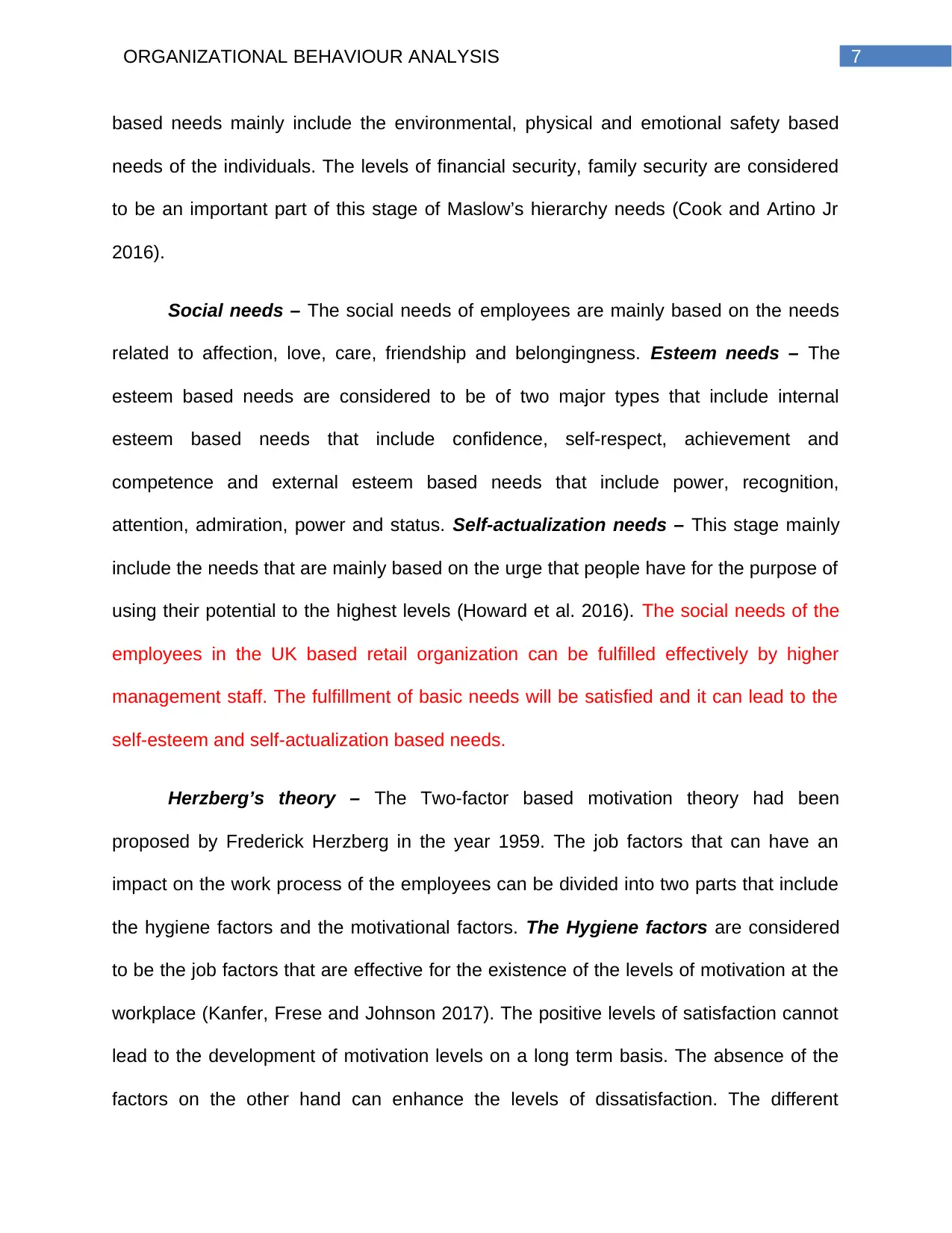
7ORGANIZATIONAL BEHAVIOUR ANALYSIS
based needs mainly include the environmental, physical and emotional safety based
needs of the individuals. The levels of financial security, family security are considered
to be an important part of this stage of Maslow’s hierarchy needs (Cook and Artino Jr
2016).
Social needs – The social needs of employees are mainly based on the needs
related to affection, love, care, friendship and belongingness. Esteem needs – The
esteem based needs are considered to be of two major types that include internal
esteem based needs that include confidence, self-respect, achievement and
competence and external esteem based needs that include power, recognition,
attention, admiration, power and status. Self-actualization needs – This stage mainly
include the needs that are mainly based on the urge that people have for the purpose of
using their potential to the highest levels (Howard et al. 2016). The social needs of the
employees in the UK based retail organization can be fulfilled effectively by higher
management staff. The fulfillment of basic needs will be satisfied and it can lead to the
self-esteem and self-actualization based needs.
Herzberg’s theory – The Two-factor based motivation theory had been
proposed by Frederick Herzberg in the year 1959. The job factors that can have an
impact on the work process of the employees can be divided into two parts that include
the hygiene factors and the motivational factors. The Hygiene factors are considered
to be the job factors that are effective for the existence of the levels of motivation at the
workplace (Kanfer, Frese and Johnson 2017). The positive levels of satisfaction cannot
lead to the development of motivation levels on a long term basis. The absence of the
factors on the other hand can enhance the levels of dissatisfaction. The different
based needs mainly include the environmental, physical and emotional safety based
needs of the individuals. The levels of financial security, family security are considered
to be an important part of this stage of Maslow’s hierarchy needs (Cook and Artino Jr
2016).
Social needs – The social needs of employees are mainly based on the needs
related to affection, love, care, friendship and belongingness. Esteem needs – The
esteem based needs are considered to be of two major types that include internal
esteem based needs that include confidence, self-respect, achievement and
competence and external esteem based needs that include power, recognition,
attention, admiration, power and status. Self-actualization needs – This stage mainly
include the needs that are mainly based on the urge that people have for the purpose of
using their potential to the highest levels (Howard et al. 2016). The social needs of the
employees in the UK based retail organization can be fulfilled effectively by higher
management staff. The fulfillment of basic needs will be satisfied and it can lead to the
self-esteem and self-actualization based needs.
Herzberg’s theory – The Two-factor based motivation theory had been
proposed by Frederick Herzberg in the year 1959. The job factors that can have an
impact on the work process of the employees can be divided into two parts that include
the hygiene factors and the motivational factors. The Hygiene factors are considered
to be the job factors that are effective for the existence of the levels of motivation at the
workplace (Kanfer, Frese and Johnson 2017). The positive levels of satisfaction cannot
lead to the development of motivation levels on a long term basis. The absence of the
factors on the other hand can enhance the levels of dissatisfaction. The different
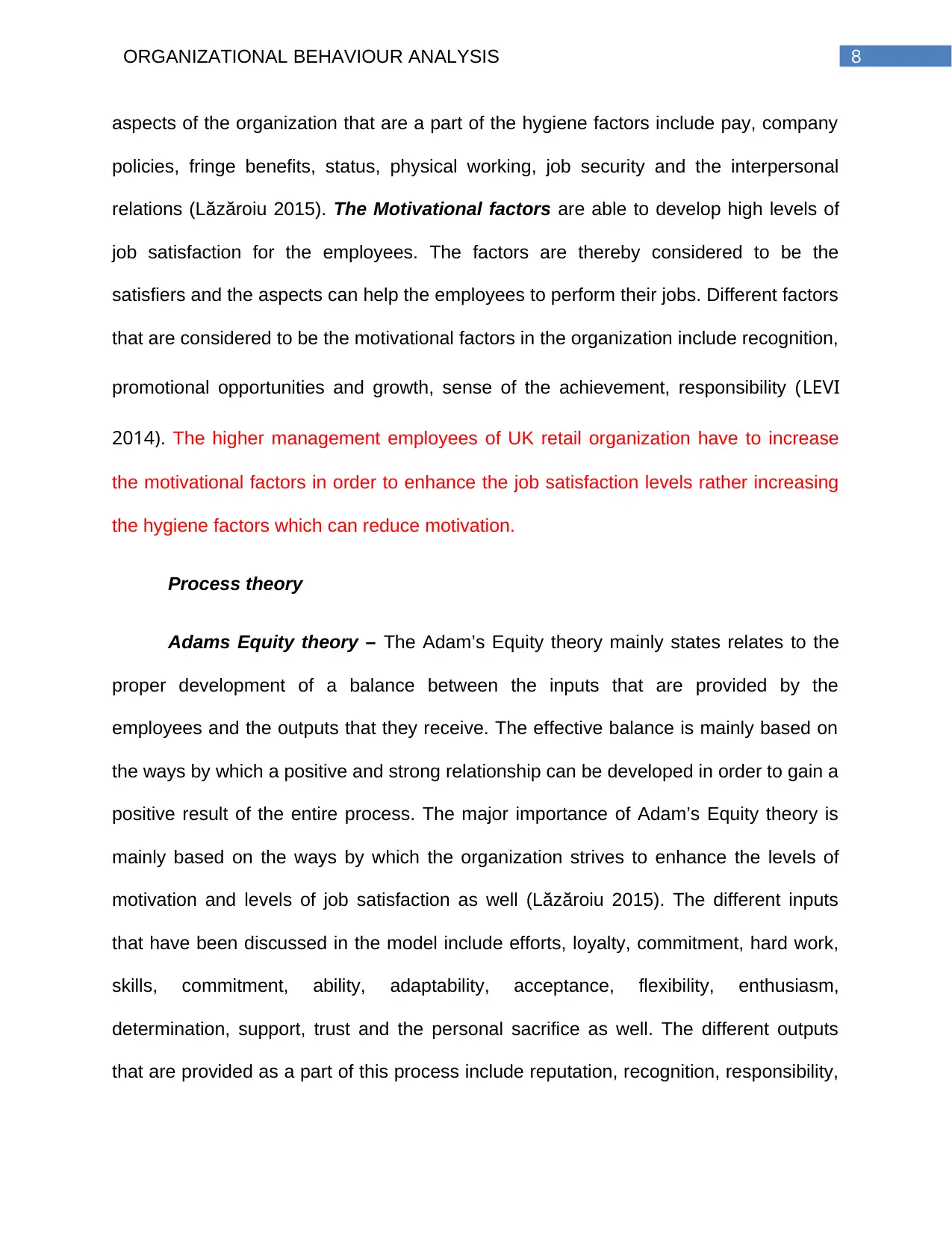
8ORGANIZATIONAL BEHAVIOUR ANALYSIS
aspects of the organization that are a part of the hygiene factors include pay, company
policies, fringe benefits, status, physical working, job security and the interpersonal
relations (Lăzăroiu 2015). The Motivational factors are able to develop high levels of
job satisfaction for the employees. The factors are thereby considered to be the
satisfiers and the aspects can help the employees to perform their jobs. Different factors
that are considered to be the motivational factors in the organization include recognition,
promotional opportunities and growth, sense of the achievement, responsibility (LEVI
2014). The higher management employees of UK retail organization have to increase
the motivational factors in order to enhance the job satisfaction levels rather increasing
the hygiene factors which can reduce motivation.
Process theory
Adams Equity theory – The Adam’s Equity theory mainly states relates to the
proper development of a balance between the inputs that are provided by the
employees and the outputs that they receive. The effective balance is mainly based on
the ways by which a positive and strong relationship can be developed in order to gain a
positive result of the entire process. The major importance of Adam’s Equity theory is
mainly based on the ways by which the organization strives to enhance the levels of
motivation and levels of job satisfaction as well (Lăzăroiu 2015). The different inputs
that have been discussed in the model include efforts, loyalty, commitment, hard work,
skills, commitment, ability, adaptability, acceptance, flexibility, enthusiasm,
determination, support, trust and the personal sacrifice as well. The different outputs
that are provided as a part of this process include reputation, recognition, responsibility,
aspects of the organization that are a part of the hygiene factors include pay, company
policies, fringe benefits, status, physical working, job security and the interpersonal
relations (Lăzăroiu 2015). The Motivational factors are able to develop high levels of
job satisfaction for the employees. The factors are thereby considered to be the
satisfiers and the aspects can help the employees to perform their jobs. Different factors
that are considered to be the motivational factors in the organization include recognition,
promotional opportunities and growth, sense of the achievement, responsibility (LEVI
2014). The higher management employees of UK retail organization have to increase
the motivational factors in order to enhance the job satisfaction levels rather increasing
the hygiene factors which can reduce motivation.
Process theory
Adams Equity theory – The Adam’s Equity theory mainly states relates to the
proper development of a balance between the inputs that are provided by the
employees and the outputs that they receive. The effective balance is mainly based on
the ways by which a positive and strong relationship can be developed in order to gain a
positive result of the entire process. The major importance of Adam’s Equity theory is
mainly based on the ways by which the organization strives to enhance the levels of
motivation and levels of job satisfaction as well (Lăzăroiu 2015). The different inputs
that have been discussed in the model include efforts, loyalty, commitment, hard work,
skills, commitment, ability, adaptability, acceptance, flexibility, enthusiasm,
determination, support, trust and the personal sacrifice as well. The different outputs
that are provided as a part of this process include reputation, recognition, responsibility,
⊘ This is a preview!⊘
Do you want full access?
Subscribe today to unlock all pages.

Trusted by 1+ million students worldwide
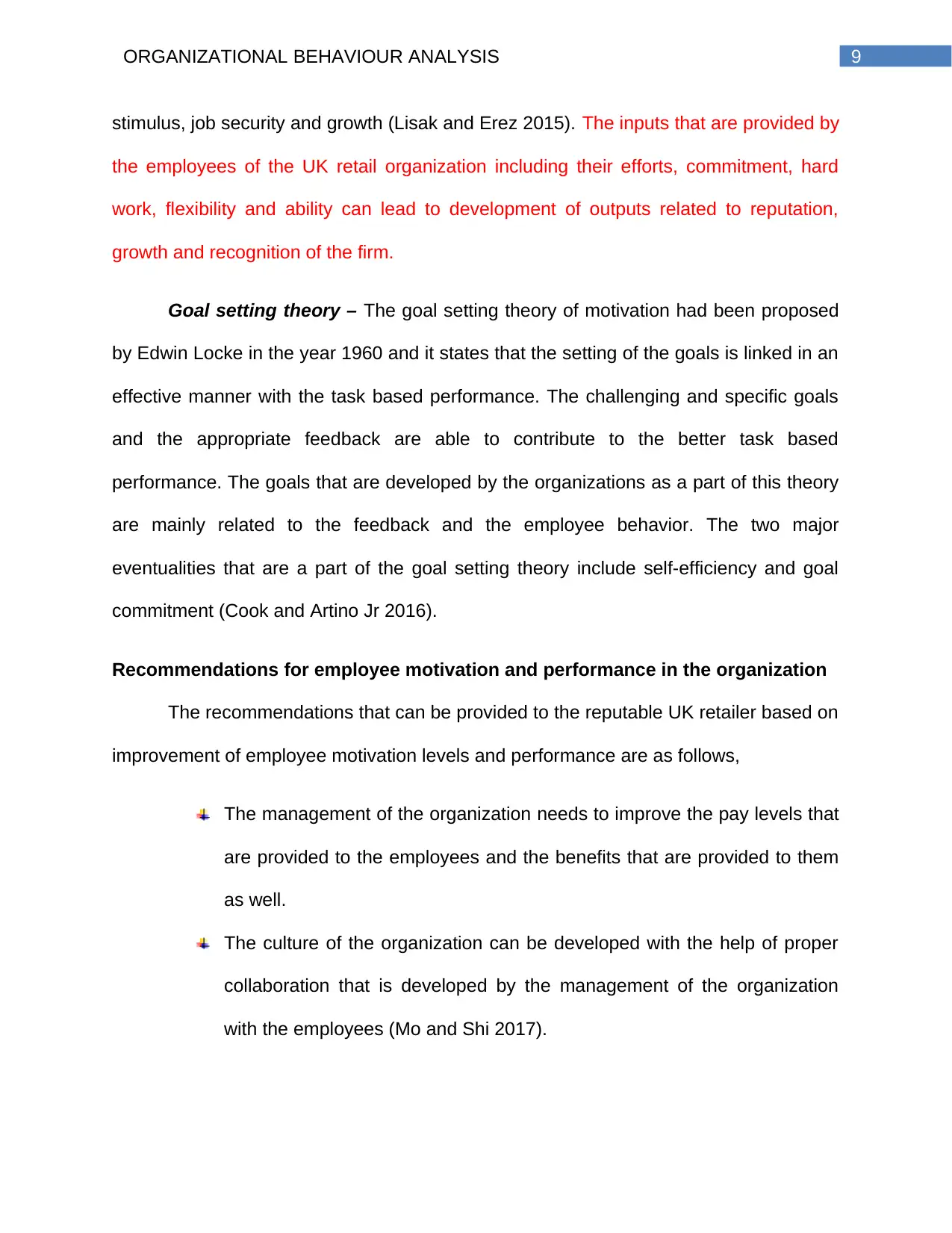
9ORGANIZATIONAL BEHAVIOUR ANALYSIS
stimulus, job security and growth (Lisak and Erez 2015). The inputs that are provided by
the employees of the UK retail organization including their efforts, commitment, hard
work, flexibility and ability can lead to development of outputs related to reputation,
growth and recognition of the firm.
Goal setting theory – The goal setting theory of motivation had been proposed
by Edwin Locke in the year 1960 and it states that the setting of the goals is linked in an
effective manner with the task based performance. The challenging and specific goals
and the appropriate feedback are able to contribute to the better task based
performance. The goals that are developed by the organizations as a part of this theory
are mainly related to the feedback and the employee behavior. The two major
eventualities that are a part of the goal setting theory include self-efficiency and goal
commitment (Cook and Artino Jr 2016).
Recommendations for employee motivation and performance in the organization
The recommendations that can be provided to the reputable UK retailer based on
improvement of employee motivation levels and performance are as follows,
The management of the organization needs to improve the pay levels that
are provided to the employees and the benefits that are provided to them
as well.
The culture of the organization can be developed with the help of proper
collaboration that is developed by the management of the organization
with the employees (Mo and Shi 2017).
stimulus, job security and growth (Lisak and Erez 2015). The inputs that are provided by
the employees of the UK retail organization including their efforts, commitment, hard
work, flexibility and ability can lead to development of outputs related to reputation,
growth and recognition of the firm.
Goal setting theory – The goal setting theory of motivation had been proposed
by Edwin Locke in the year 1960 and it states that the setting of the goals is linked in an
effective manner with the task based performance. The challenging and specific goals
and the appropriate feedback are able to contribute to the better task based
performance. The goals that are developed by the organizations as a part of this theory
are mainly related to the feedback and the employee behavior. The two major
eventualities that are a part of the goal setting theory include self-efficiency and goal
commitment (Cook and Artino Jr 2016).
Recommendations for employee motivation and performance in the organization
The recommendations that can be provided to the reputable UK retailer based on
improvement of employee motivation levels and performance are as follows,
The management of the organization needs to improve the pay levels that
are provided to the employees and the benefits that are provided to them
as well.
The culture of the organization can be developed with the help of proper
collaboration that is developed by the management of the organization
with the employees (Mo and Shi 2017).
Paraphrase This Document
Need a fresh take? Get an instant paraphrase of this document with our AI Paraphraser
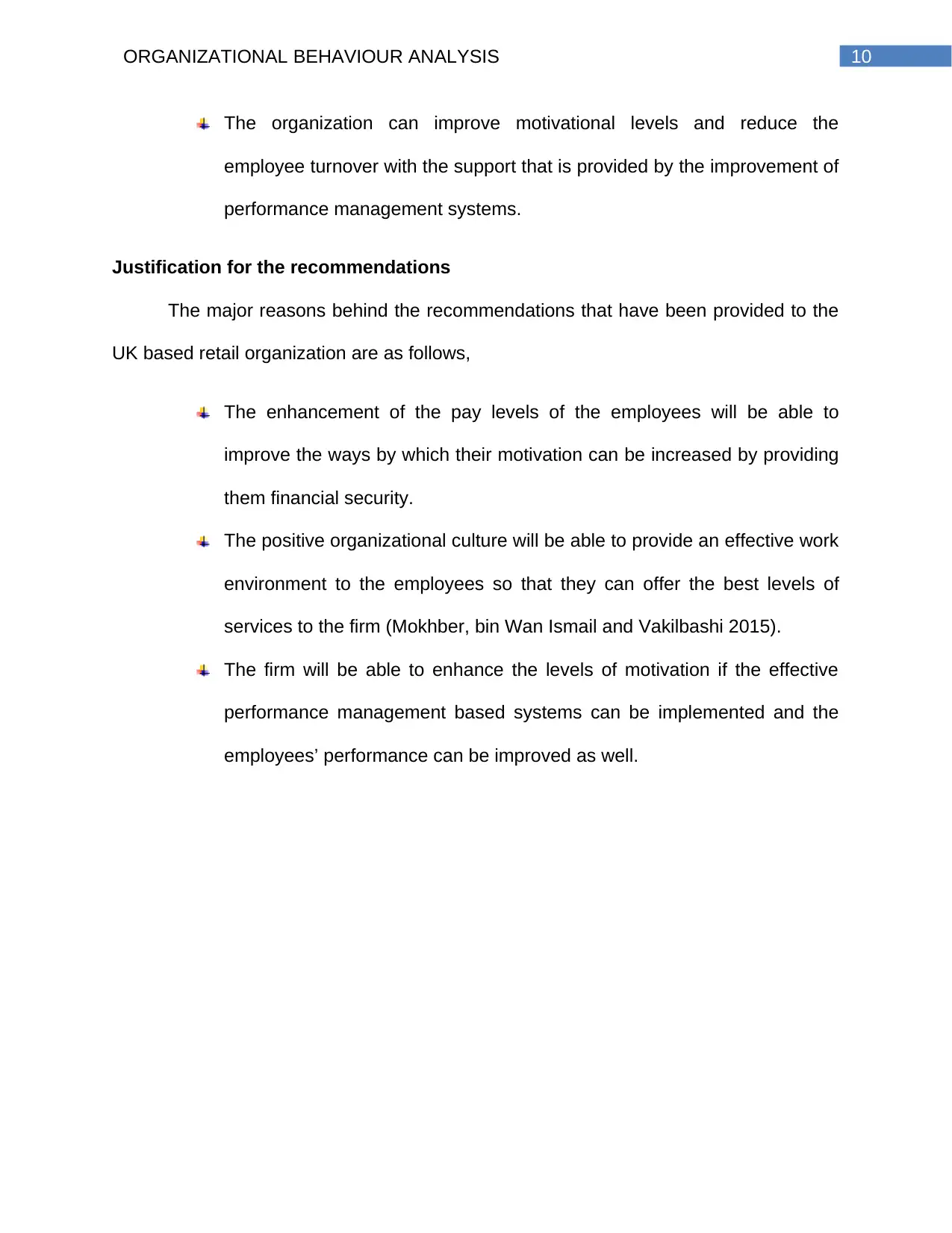
10ORGANIZATIONAL BEHAVIOUR ANALYSIS
The organization can improve motivational levels and reduce the
employee turnover with the support that is provided by the improvement of
performance management systems.
Justification for the recommendations
The major reasons behind the recommendations that have been provided to the
UK based retail organization are as follows,
The enhancement of the pay levels of the employees will be able to
improve the ways by which their motivation can be increased by providing
them financial security.
The positive organizational culture will be able to provide an effective work
environment to the employees so that they can offer the best levels of
services to the firm (Mokhber, bin Wan Ismail and Vakilbashi 2015).
The firm will be able to enhance the levels of motivation if the effective
performance management based systems can be implemented and the
employees’ performance can be improved as well.
The organization can improve motivational levels and reduce the
employee turnover with the support that is provided by the improvement of
performance management systems.
Justification for the recommendations
The major reasons behind the recommendations that have been provided to the
UK based retail organization are as follows,
The enhancement of the pay levels of the employees will be able to
improve the ways by which their motivation can be increased by providing
them financial security.
The positive organizational culture will be able to provide an effective work
environment to the employees so that they can offer the best levels of
services to the firm (Mokhber, bin Wan Ismail and Vakilbashi 2015).
The firm will be able to enhance the levels of motivation if the effective
performance management based systems can be implemented and the
employees’ performance can be improved as well.
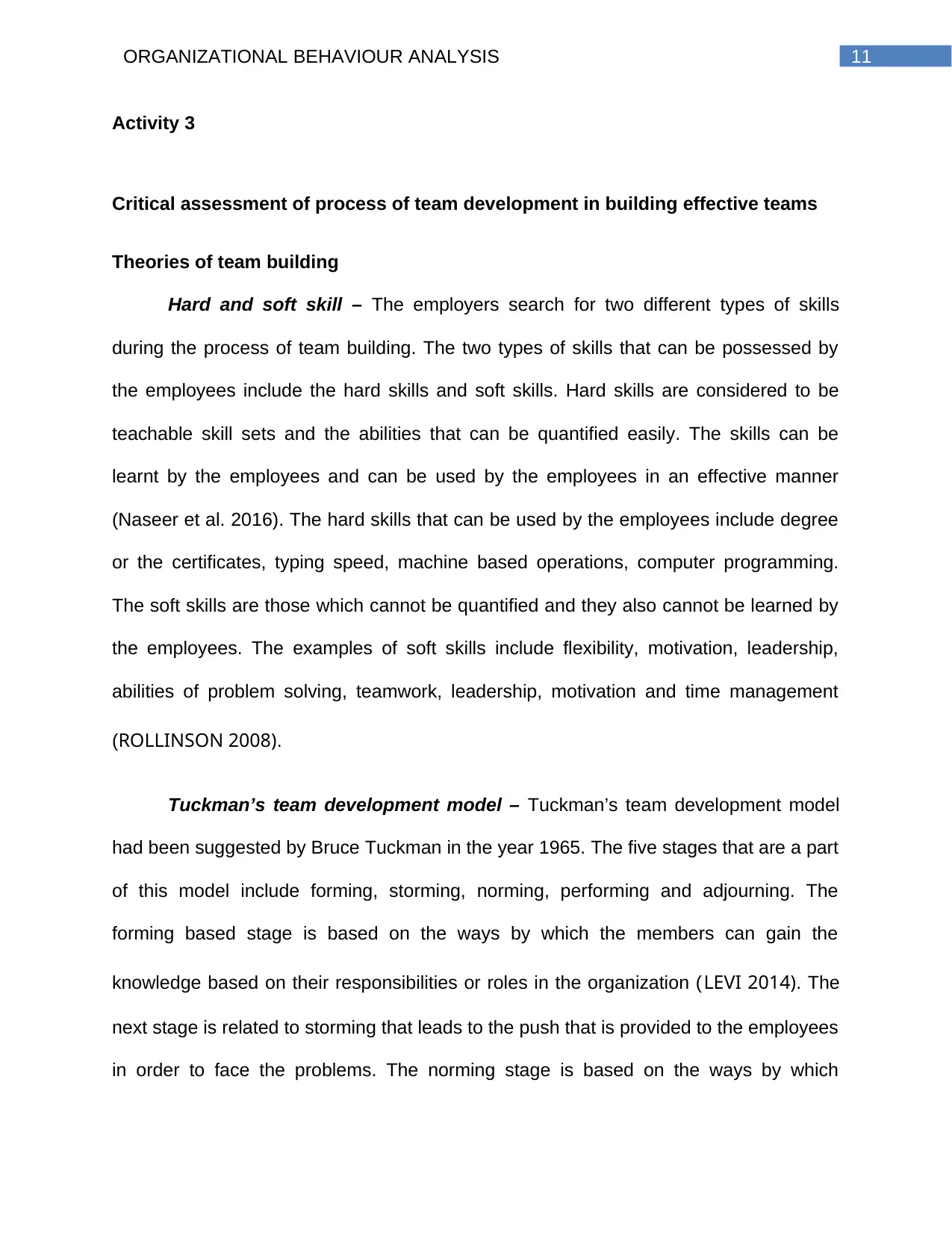
11ORGANIZATIONAL BEHAVIOUR ANALYSIS
Activity 3
Critical assessment of process of team development in building effective teams
Theories of team building
Hard and soft skill – The employers search for two different types of skills
during the process of team building. The two types of skills that can be possessed by
the employees include the hard skills and soft skills. Hard skills are considered to be
teachable skill sets and the abilities that can be quantified easily. The skills can be
learnt by the employees and can be used by the employees in an effective manner
(Naseer et al. 2016). The hard skills that can be used by the employees include degree
or the certificates, typing speed, machine based operations, computer programming.
The soft skills are those which cannot be quantified and they also cannot be learned by
the employees. The examples of soft skills include flexibility, motivation, leadership,
abilities of problem solving, teamwork, leadership, motivation and time management
(ROLLINSON 2008).
Tuckman’s team development model – Tuckman’s team development model
had been suggested by Bruce Tuckman in the year 1965. The five stages that are a part
of this model include forming, storming, norming, performing and adjourning. The
forming based stage is based on the ways by which the members can gain the
knowledge based on their responsibilities or roles in the organization (LEVI 2014). The
next stage is related to storming that leads to the push that is provided to the employees
in order to face the problems. The norming stage is based on the ways by which
Activity 3
Critical assessment of process of team development in building effective teams
Theories of team building
Hard and soft skill – The employers search for two different types of skills
during the process of team building. The two types of skills that can be possessed by
the employees include the hard skills and soft skills. Hard skills are considered to be
teachable skill sets and the abilities that can be quantified easily. The skills can be
learnt by the employees and can be used by the employees in an effective manner
(Naseer et al. 2016). The hard skills that can be used by the employees include degree
or the certificates, typing speed, machine based operations, computer programming.
The soft skills are those which cannot be quantified and they also cannot be learned by
the employees. The examples of soft skills include flexibility, motivation, leadership,
abilities of problem solving, teamwork, leadership, motivation and time management
(ROLLINSON 2008).
Tuckman’s team development model – Tuckman’s team development model
had been suggested by Bruce Tuckman in the year 1965. The five stages that are a part
of this model include forming, storming, norming, performing and adjourning. The
forming based stage is based on the ways by which the members can gain the
knowledge based on their responsibilities or roles in the organization (LEVI 2014). The
next stage is related to storming that leads to the push that is provided to the employees
in order to face the problems. The norming stage is based on the ways by which
⊘ This is a preview!⊘
Do you want full access?
Subscribe today to unlock all pages.

Trusted by 1+ million students worldwide
1 out of 20
Related Documents
Your All-in-One AI-Powered Toolkit for Academic Success.
+13062052269
info@desklib.com
Available 24*7 on WhatsApp / Email
![[object Object]](/_next/static/media/star-bottom.7253800d.svg)
Unlock your academic potential
Copyright © 2020–2025 A2Z Services. All Rights Reserved. Developed and managed by ZUCOL.




